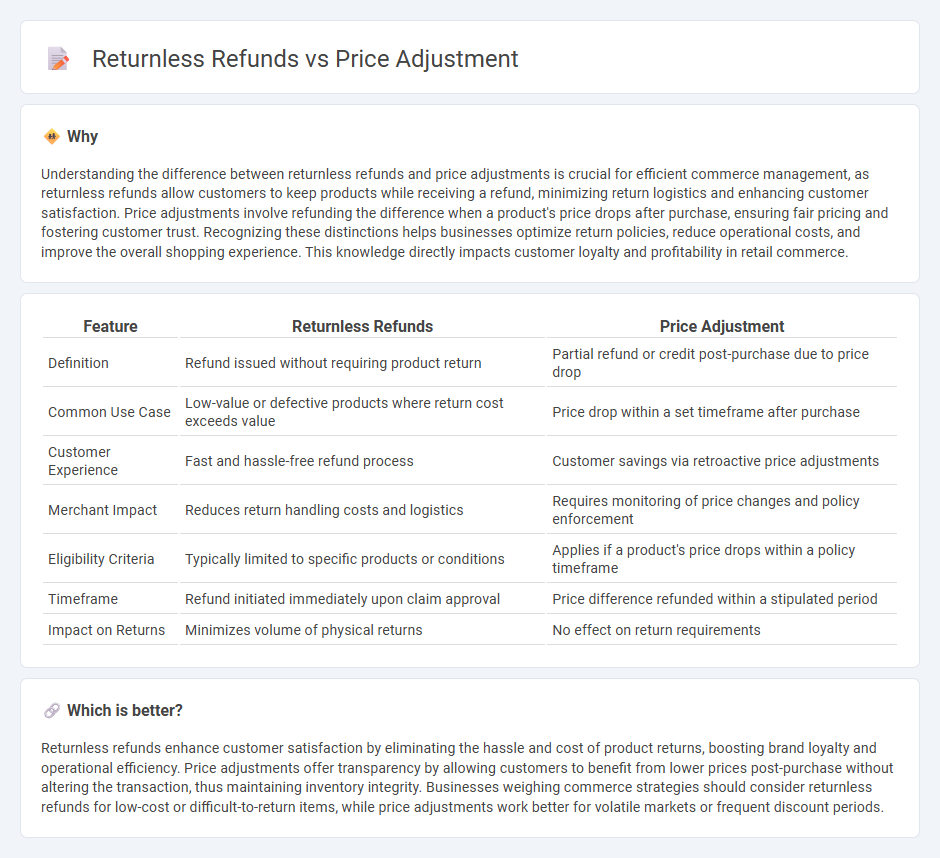
Returnless refunds eliminate the need for customers to ship back items, reducing processing time and operational costs, while price adjustments compensate buyers who paid higher prices by refunding the difference without returning the product. Both strategies enhance customer satisfaction and streamline commerce operations, particularly in e-commerce and retail environments where returns can be complex and costly. Explore in-depth comparisons of returnless refunds and price adjustments to optimize your commerce strategy.
Why it is important
Understanding the difference between returnless refunds and price adjustments is crucial for efficient commerce management, as returnless refunds allow customers to keep products while receiving a refund, minimizing return logistics and enhancing customer satisfaction. Price adjustments involve refunding the difference when a product's price drops after purchase, ensuring fair pricing and fostering customer trust. Recognizing these distinctions helps businesses optimize return policies, reduce operational costs, and improve the overall shopping experience. This knowledge directly impacts customer loyalty and profitability in retail commerce.
Comparison Table
| Feature | Returnless Refunds | Price Adjustment |
|---|---|---|
| Definition | Refund issued without requiring product return | Partial refund or credit post-purchase due to price drop |
| Common Use Case | Low-value or defective products where return cost exceeds value | Price drop within a set timeframe after purchase |
| Customer Experience | Fast and hassle-free refund process | Customer savings via retroactive price adjustments |
| Merchant Impact | Reduces return handling costs and logistics | Requires monitoring of price changes and policy enforcement |
| Eligibility Criteria | Typically limited to specific products or conditions | Applies if a product's price drops within a policy timeframe |
| Timeframe | Refund initiated immediately upon claim approval | Price difference refunded within a stipulated period |
| Impact on Returns | Minimizes volume of physical returns | No effect on return requirements |
Which is better?
Returnless refunds enhance customer satisfaction by eliminating the hassle and cost of product returns, boosting brand loyalty and operational efficiency. Price adjustments offer transparency by allowing customers to benefit from lower prices post-purchase without altering the transaction, thus maintaining inventory integrity. Businesses weighing commerce strategies should consider returnless refunds for low-cost or difficult-to-return items, while price adjustments work better for volatile markets or frequent discount periods.
Connection
Returnless refunds enhance customer satisfaction by allowing consumers to keep unwanted products while receiving full refunds, reducing return shipping costs for businesses. Price adjustment policies complement returnless refunds by enabling retailers to refund the difference when a product's price drops shortly after purchase, fostering trust and encouraging repeat sales. Both strategies optimize operational efficiency and improve the overall shopping experience in ecommerce.
Key Terms
Dynamic pricing
Dynamic pricing enables real-time price adjustments based on market demand, competitor pricing, and inventory levels, improving revenue optimization without immediate product returns. Returnless refunds offer customer satisfaction by issuing partial or full refunds without requiring product return, reducing logistics costs and increasing convenience. Explore how integrating dynamic pricing with returnless refund strategies can enhance profitability and customer loyalty in your business model.
Refund policy
Price adjustment policies allow customers to receive a refund difference if an item's price drops within a specific period after purchase, enhancing customer satisfaction and trust. Returnless refunds eliminate the need to send items back for a refund, reducing processing costs and improving the overall customer experience while maintaining flexibility in returns management. Explore more about optimizing refund policies to balance cost, efficiency, and customer loyalty.
Customer retention
Price adjustment policies allow customers to receive a refund if a product's price drops shortly after purchase, enhancing customer satisfaction and trust. Returnless refunds eliminate the hassle of returning items, reducing operational costs while fostering goodwill and loyalty in e-commerce. Explore how these strategies can improve customer retention and optimize your business approach.
Source and External Links
What is a Pricing Adjustment? - DealHub - A pricing adjustment is any modification made to the original price of a product or service in response to market conditions, cost changes, competition, and strategic goals.
Price Adjustment Clause: Inflation-Proof Your Contracts - Icertis - A price adjustment clause is a contract provision allowing the price of goods or services to change based on external factors such as inflation, raw material costs, or labor expenses.
Price adjustment (retail) - Wikipedia - Price adjustments in retail allow customers to receive a partial refund if the price of a purchased item drops within a specific timeframe, often called price protection.
 dowidth.com
dowidth.com